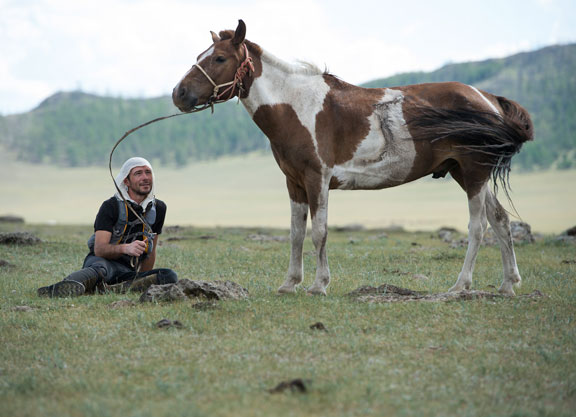By Kelsey Riley
The Mongol Derby wants to kill you.
I had been warned of it. I had started to suspect it. Now, as a pair of snarling dogs came lurching at me as I hung off the side of my bolting horse, I knew it to be true.
We had been galloping for 10 kilometers down a desolate dirt road through what appeared to be an equine cemetery, with horse skulls and bits of bone scattered across the green knolls. Rounding a bend, we found ourselves face-to-face with a fully intact horse skeleton. As my horse spooked, launching me half out of the saddle, two dogs blasted out of a ger, biting at his ankles as I struggled to hang on.
Really? This is how I'm going to die? A year of preparation to ride 620 miles across the Mongolian steppe and I'm going to be ripped to pieces just four days in by two angry, potentially rabid dogs?
“Not today, boys!” I shouted as I hauled myself back up onto the saddle. As we reached the edges of their territory, the dogs backed off and slowly disappeared into the distance.
Welcome to the Mongol Derby. That was pretty much a typical moment in the world's longest and toughest horse race, where riders have 10 days to navigate 1,000 kilometers of the Mongolian steppe on the backs of semi-wild horses.
That sounds hectic. But at least you can follow the track, right?
Think again. There is no marked course; riders navigate from the start to the finish, and the 28 stations in between, by GPS. They're given waypoints to help guide them, but exactly how they get there is their choice. Participants are permitted to ride from 6:30 a.m. to 8 p.m.
Near 14-hour days in the saddle? It must feel nice at night to take a hot shower, chow down on a big-ole pizza, and curl up in a warm bed.
Wrong. Riders stay out in traditional nomad style in gers-effectively an elaborate tent-but this is not glamping: there is no plumbing, electricity, beds, and certainly no pizza delivery. Showers are a nightly rub-down with a wet wipe. Toilets are a hole in the ground protected on three sides by a tarp. The fancy ones had a half-wet roll of toilet paper sitting nearby in the grass.
In August, I rode in-and finished-the 10th running of the Mongol Derby. I am not a professional rider, I had never camped, and my navigation skills are highly suspect. It was the most spectacular and rewarding experience of my life. What follows is a taste of the joy, fear, pain, and elation I went through.
***
The plain bay horse rolled his wide eyes back nervously, snorting and leaning backward as I stepped in front of him.
“That one,” I called to the herder. He had a craziness about him, sure, but I liked it. It was 6 a.m. on day two of the Mongol Derby, and the evening before I had slugged through a torrential rainstorm on a horse that wouldn't go past a trot. I didn't want to risk that again.
Fiery he was. We raced up and down mountains and across marmot hole-infested plains. Rocketship repeatedly went down on his knees, face, belly, etc., but somehow managed to not lose total control, or me.
“I'm actually going to die,” I thought as we hurtled across a vast spread of knolls that I felt sure his hooves would slip between. I cringed as he tore across piles of rocks, but stone bruises? Not a concern for this dude.
By the time I arrived at station six, my third stop of the day, I was riding with a group of guys from Australia. I wasn't afraid to admit that exhaustion and pain were catching up to me.
“Do you guys mind if I carry on with you to the next station?” I asked. “I'm getting a bit tired and sore and the company will keep my spirits up.”
They didn't mind. In fact, one even hooked me up with some super painkillers.
“Take this; you won't feel a thing,” he said, dropping a small white pill in my hand.
I know: this is how a mediocre horror film begins. But one can get pretty desperate out on the steppe. And these guys seemed okay. Soon, a blissful numbness washed over me, and I'm sure I spent the rest of the day telling the guys how happy I was. We rolled into station seven, one of the most beautiful stops on the race, with 15 minutes until cutoff time.
Not a subscriber? Click here to sign up for the daily PDF or alerts.






